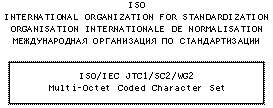
ISO/IEC JTC1/SC2/WG2 N1442 FINAL DRAFT
Date: 1996-07-22
This is an unofficial HTML version of a document submitted to WG2.
Title: Proposal for a new Alphabetic Rapporteur Group (ARG)
Source: Michael Everson, Everson Gunn Teoranta (IE)
Status: Expert Contribution
Action: WG2 Resolution
A source of pressure on the resources of WG2 has been the lengthy discussion of the addition of small sets of characters to ISO 10646. This does not imply that the characters discussed are unimportant, but that since there have been differing views as to their suitability for encoding in ISO 10646, or their suitability for encoding in the BMP of ISO 10646, a great deal of committee time has been given to their discussion, often without definitive action taken.
It has been observed that the Ideographic Rapporteur Group has been an effective means for interested parties to work off-line on relatively large repertoires, and for prioritizing them with regard to their importance. At the CEN/TC304 meeting in Copenhagen the week following the SC2/WG2 meeting, considerable time was spent discussing European requirements for alphabetic characters and the inefficiency of the current process of proposing them for inclusion in ISO 10646. It was proposed at that time that an ERG or European Rapporteur Group be created within SC2/WG2, to which CEN/TC304/WG2 and WG3 would have input.
It is here proposed that such a group not be limited to European interests, but be given a broader scope, to include a wider range of members of SC2/WG2, and to assemble a repertoire of characters belonging to alphabetic scripts, primarily Latin, Greek, and Cyrillic scripts, but including Georgian or Armenian or other minor extinct alphabetic scripts as well should the need arise.
The rationale for not limiting membership of this ARG or Alphabetic Rapporteur Group is simple, and the example of the proposed pinyin character LATIN SMALL LETTER N WITH GRAVE by China is a good one. It was quickly noticed that a Canadian aboriginal language, Montaignais, also required this character as well as the character LATIN CAPITAL LETTER N WITH GRAVE. No particular benefit would be derived from limiting the discussion to European member bodies, some of which have been concerned with alphabetic characters used in Africa or North America. The ARG could work more effectively with the Unicode Technical Committee as well, a very important benefit to the work of WG2.
The general technical benefits which would arise from the work of the ARG are clear. The Group could collect data, ensure that the proposal summary forms were uniform and complete, and could apply a set of priorities regarding the utility and urgency of certain characters (their use as basic characters in natural languages for instance) with regard to providing informed, expert recommendations to WG2 regarding the acceptance of characters into ISO 10646 and inside or outside of the BMP. SC2/WG2 would thus be assured that a high level of expertise had been applied to the scrutinization of new alphabetic characters proposed.
The ARG would work off-line, reporting to WG2 on a regular basis, and presenting polished repertoires for acceptance into the standard as the repertoires were considered complete, or as urgently required characters were recognized. The ARG could work primarily by electronic mail, and reference documents regarding proposed characters could be made available on the Web. In a sense, the ARG would be the maintainer of the "Alphabetic Bucket", to use a phrase coined at the Copenhagen meeting.
T�ir go dt� inn�acs EGT
(Go to the EGT index)
Michael Everson, Dublin, 1996-08-12

